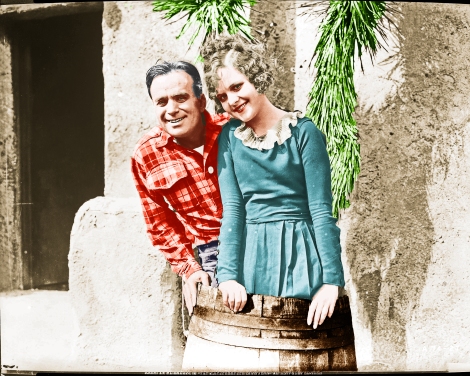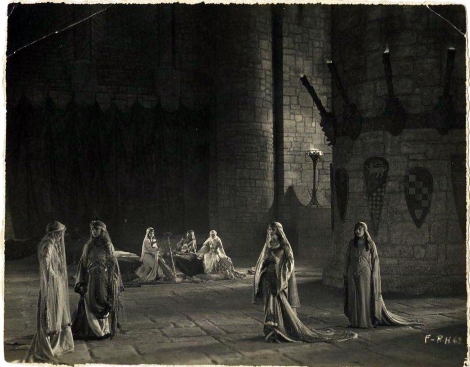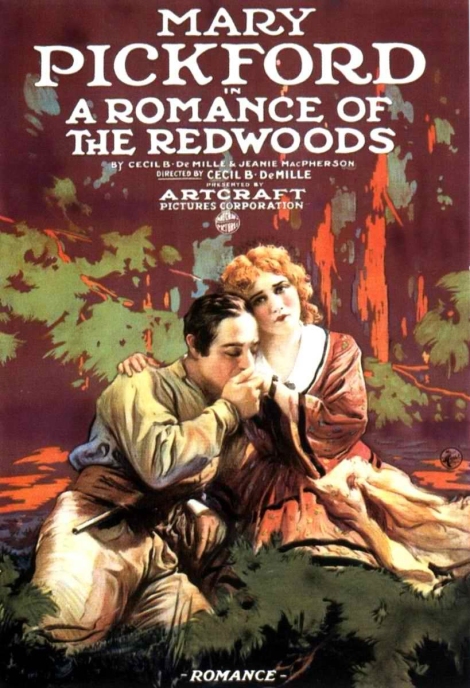Here they are – this year’s selection of wall calendars with my colorized photos that I created during this past year. Obtaining your copy is easy, just print them out. They look great in 8×10!
Douglas Fairbanks (1883-1939) was one of the first movie super stars long before that term was ever coined. A young “juvenile” actor on the stage, Doug gave early films a try in 1915 in a series of popular modern dress comedies. He added some incredible athletic stunts that left movie audiences amazed. By 1917, he was one of the highest paid stars but Doug wasn’t content and decided to produce his own films. He became a partner with his pal Charlie Chaplin, the great director D.W. Griffith, and Mary Pickford (whom he married in 1920) to form United Artists. This company is still in business today.
One of Doug’s earlier films, the now-lost KNICKERBOCKER BUCKAROO (1919) with Marjorie Daw:

Doug Fairbanks literally invented the “action” film genre that remains extremely popular – think Jackie Chan. In 1922, Fairbanks began his most ambitious production yet, a swashbuckler chronicling the legends of Robin Hood. No, it wasn’t a primitive version of the later Errol Flynn film, but a fully developed saga of how the Earl of Huntingdon went from being one of the noble Knights of the Realm to the hunted outlaw Robin Hood rebelling against the unscrupulous Prince John. Fairbanks wanted his film to have the look and feel of old illuminated manuscripts that recalled the glorious Age of Chivalry – and he got it!

No expense was spared as Fairbanks literally built a full-scale castle on the studio lot. He recruited top art directors Wilfred Buckland and William Cameron Menzies, and costume designer Mitchell Leisen (later a major film director). This original color German transparency gives you a good idea of the magnificent sets:

A rare still with another view of the castle:

Robin Hood with Maid Marian, played by Enid Bennett – another German color transparency:

Fencing expert Frank Cavens designed the sword stunts as he would for many later swashbucklers including the Flynn ROBIN HOOD:

Fairbanks as Robin Hood is the master of all he surveys:

Sheet music was published for playing the love theme at home on the piano:

Not to mention a book version of the film’s story:

In 1926, four years after the tremendous success of ROBIN HOOD, and two more epics, Doug was ready for a new challenge: he wanted to be the first major star to produce a film entirely in Technicolor. The result was THE BLACK PIRATE:

These are original color plates from the rare Photoplay Edition novelization of the screenplay:

THE BLACK PIRATE has been restored to its original Technicolor brilliance and is available today on DVD and Blu-ray. Likewise, Douglas Fairbanks in ROBIN HOOD is restored and available on DVD. Both films can also be viewed on streaming video. Fairbanks would no doubt be pleased that his productions continue to delight viewers well into the 21st century!
Mary Pickford (1892-1979) was a multi-talented film star and producer, a founding partner of United Artists in 1919, and a co-founder of the Academy of Motion Picture Arts and Sciences in 1927. For all of that, she was a wonderfully unassuming person and everyone who ever met her instantly liked her. On May 25, 1959, Mary gave this wide-ranging interview at her legendary home, Pickfair, located near Los Angeles. She discussed her early life and family in Toronto, her start in films, and her impressions of many of the greats she worked with including D.W. Griffith, Cecil B. DeMille, Ernst Lubitsch, Douglas Fairbanks Sr., and others. Click below to spend 45 minutes with one of the most accomplished women of the 20th century:
Mary began appearing in films in 1909 and quite a number of her early films survive. Below, a still from ESMERALDA (1915), one of the lost ones:

Mary’s younger brother Jack became a silent screen star in his own right but his troubled private life was riddled with substance abuse and he would not fulfill his early potential. Mary helped Jack in every way she could:

Pickford was tireless in her fundraising efforts to sell war bonds during America’s involvement in the First World War. This extended to her making propaganda films to support the war effort such as this 1918 release:

Mary speaks about director Cecil B. DeMille in our interview. She made two films for him, THE LITTLE AMERICAN and A ROMANCE OF THE REDWOODS (both 1917), but the collaboration was not a happy one:

Despite widespread resentment against Germany and Germans after the First World War, Mary brought famed German director Ernst Lubitsch to Hollywood to direct her in his first American film. But Mary was used to directing her director by then and the film, ROSITA (1923), was an unhappy experience as she observes in the interview:

ROSITA was a departure from Mary’s screen character and she went further in the plush costume drama, DOROTHY VERNON OF HADDON HALL (1924), based on a popular novel of the time:

The arrival of sound films in the late 1920s shook the status quo of the studios but Mary won the Best Actress Academy Award for her first talkie and most financially successful film, COQUETTE (1929):

Mary co-starred with her husband Doug Fairbanks Sr. for his talkie debut in THE TAMING OF THE SHREW (1929):

Mary pursued numerous projects during the 1930s including radio broadcasting. Here she runs through the script with bandleader Al Lyon, director of the Coconut Grove Orchestra, for the debut of Mary’s show, Parties At Pickfair, on February 9, 1936:

Mary was able to obtain top film stars for her show including Errol Flynn:

Mary Pickford received a second, special Academy Award in 1976, which was presented to her at Pickfair. She passed away in 1979 and was survived by her third husband, actor and bandleader Charles “Buddy” Rogers, whom she married in 1937 following her divorce from Fairbanks. Despite her plans for turning Pickfair into a museum as she discusses in the interview, after her death it was eventually sold to Pia Zadora in 1988, who had it torn down claiming termite infestation. Years later, Zadora stated that Pickfair wasn’t razed due to termites, but because of ghosts.
(Pickford Interview courtesy of the Internet Archives at https://archive.org)
A few weeks ago we visited MGM for a Hollywood Party so now let’s give equal time to one of Metro’s rival studios – the fabulous Twentieth Century-Fox. The “hyphen” in the name acknowledges a merger between the then-recently formed Twentieth Century Pictures (1933) and the more venerable but ailing Fox studio. The occasion of this particular radio party is to launch the new film, ALEXANDER’S RAGTIME BAND, but since all the film’s songs were written by Irving Berlin, the broadcast is called “A Tribute to Irving Berlin,” who not only appears on the show but sings too.
This all-star broadcast is kicked off by newspaper columnist Walter Winchell who turns over the proceedings to master of ceremonies Al Jolson. Among the legendary entertainers you’ll hear are Ethel Merman, Sophie Tucker, Eddie Cantor, Connie Boswell, Paul Whiteman, and Tommy Dorsey. The show then switches gears when movie mogul Darryl Zanuck presents a radio preview of ALEXANDER’S RAGTIME BAND with its stars Tyrone Power, Alice Faye and Ethel Merman. All of this was performed live to millions of listeners on the evening of August 3, 1938, so if you want to join the party just click below and within five seconds you’ll be transported back in time to spend a full hour in Old Hollywood:
The following are thumbnail sketches of some of the celebrities appearing on the broadcast. Irving Berlin and Al Jolson went a long way back. Both became famous by 1911: Al popularized Irving’s songs and Irving’s songs helped make Jolie a star. Here they are golfing in 1929:

Sophie Tucker was known as “The Last of the Red Hot Mamas” during her career that lasted over a half century and spanned vaudeville to television:

Eddie Cantor and Al Jolson were friendly competitors both professionally and personally, on the stage, in movies, on radio and in vying to be the first to sing Berlin’s new songs. Listen to their ad-lib arguing while singing with Irving Berlin:

Irving takes the stars of ALEXANDER’S RAGTIME BAND through their paces prior to filming: Alice Faye, Tyrone Power and Don Ameche, who grew a mustache for the film. All three were newly-minted stars with only a couple of hit films behind them. No doubt they are genuinely happy to have the composer onboard their new film:

Sheet music was a popular movie tie-in during the days of Old Hollywood. See the movie, go home and play the songs on your piano – an all but forgotten way of interacting with the film:

Connee Boswell was part of the successful Boswell Sisters but when her two siblings decided to retire in 1936, she continued alone and became one the best female jazz vocalists of her era. Unknown to the public, Connee was wheelchair-bound, not unlike President Franklin Roosevelt. She originally spelled her first name as “Connie” but later changed it to “Connee” because it made signing autographs easier:

Bandleader Paul Whiteman was a big figure, literally and figuratively, in American music during much of the first half of the 20th century. He commissioned George Gershwin to write “Rhapsody in Blue” and Ferde Grofe to compose “Grand Canyon Suite,” championed jazz as a serious form of music when it was commonly dismissed as degenerate, and through his concerts, broadcasts and recordings introduced the public to Bing Crosby, Tommy and Jimmy Dorsey, Red Nichols, Mildred Bailey, Bix Beiderbecke, Hoagy Carmichael, and many others:

Darryl Zanuck receives the very first Irving G. Thalberg Memorial Award during the Academy Awards ceremony in March 1938. Silent screen star and producer Douglas Fairbanks Sr. is the presenter. This special “Oscar” is still given each year to honor outstanding film executives. The legendary Thalberg had died over a year earlier; Doug Fairbanks would die the following year and Hollywood would never be quite the same:

ALEXANDER’S RAGTIME BAND is readily available on dvd and is one of the most enjoyable musicals of the 1930s.
Bonus: Irving Berlin was inducted into the Friars Club in 1911 and, in lieu of the customary speech, he wrote and sang a very funny song just for the occasion. It was such a hit that Irving was persuaded to privately record the song on January 24, 1914. Here it is performed by the composer himself: